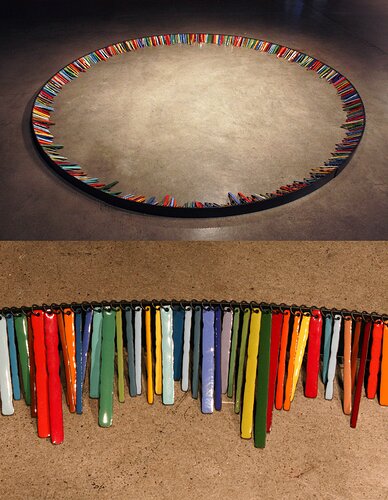Materials: Enameled and forged steel
Dimensions: 7' X 7' X 2.5"
"Let the Living Be Alive" designates a space for appreciating the life within us. Color is used as a symbol for vitality.
Photo credit: Laurie J. Marshall
Laurie J Marshall
Lauriejmarshall.com
Carbondale, IL. USA
My work consists of groups of similar objects. I bring individual parts together to make larger, organized collections. I find enjoyment in the process of repetitively making individual components. When I have built the all the parts, they come together to naturally take on a life of their own as a group. The variations and similarities in the group develop a dependence on one another to function as a whole.
I most often organize these collections into circular forms. I use the circle as a symbol, with admiration for its completeness and ability to encompass space. My most recent body of creative work is directed towards self-reflection.
I had an outdoor exhibition consisting of small and large-scale objects. “Let the Living Be Alive” took place at Devil’s Kitchen Lake in Southern Illinois. The intention of this carefully chosen site was to bring the audience out of their daily lives and into a quiet, contemplative environment.
I displayed my work along a rock cliff overlooking the lake. Each piece related to very simple life subjects, which may not be reflected on as often as I feel they should: letting go, appreciation, forgiveness, consciousness and passing away. The work is intended to evoke inner-thought, encouraging recognition and acceptance of who we are and what is going on around us.
Steel is the most common material I use for making my work. The strength and versatility of steel encourages me to use it for both small and large-scale objects. I initially developed a familiarity and interest in steel by using it to make jewelry. I find that my jewelry and sculpture tend to formally drive each other and steel is the main element tying the two together. Color is another element that often finds its place in my work. I consistently use enamel and powder coating to bring more visual information and complexity to my structures. In intend to keep exploring concepts of self-reflection, while breaking down the space between jewelry and sculpture.
The exhibition explores metal works whose primary theme is color embraced as their primary visual focus, whether that be using colored materials, exploring creating colored surfaces, or encasing the object in color.
As the world's largest jewelry related internet site, Ganoksin strives to develop exhibitions showcasing work from around the world. This exhibition was open to all metalsmiths, professional and amateur, advanced and beginner.
In total 303 artists contributed 814 show pieces for the permanent online exhibition.
The exhibition was curated by Beth Wicker, President of the North Carolina Society of Goldsmiths in the United States, and Adjunct Instructor at Northeastern Technical College in South Carolina. Director of the exhibition is Hanuman Aspler, founder of The Ganoksin Project, the world's largest internet jewelry site.
Hue is one of the primary properties of color, it refers to the place the color occupies on the visual spectrum. Humans have used hues throughout time, to create cave paintings, to decorate themselves, their clothing and their housing.
Different hues have taken on different meanings throughout time. Gold traditionally has been a color of purity - the metal gold is relatively unchangeable, and the hue of gold has come to stand for gods and goddesses, for royalty, for durability and for purity. Red has often meant love, or passion. Hues often reflect the meaning of the seasons, with pastels referring to spring and the burst of new life after the pale hues of winter. Summer is reflected in vibrant, deep hues, followed by the browning of hues in the fall as plants go to seed and die, and the land turns fallow.
The worth of a hue has often been tied to what is necessary to make the pigment that creates the hue, and the expensive involved in the process. Often created from crushed stones that had to be mined and carried by caravan over thousands of miles, or from fermented roots of plants only grown in certain areas, or the carapaces of rare insects - the creation of hue in a way that could be used by man was an involved and generally expensive process.
In today's world metalsmiths have access to perhaps the widest range of materials and hues in the history of man - and in some of the most affordable ways ever.
This exhibition celebrates hue - color - as an integral, inherent element of the work. We talk of the "richness" of color, and examples of this abound here. One expects hues from the colors of gemstones used in metalsmithing, but we also have hues from some less expected places. Glass enamels are an ancient way of adding color, as are a variety of patinas. Today's artists also use synthetic man-made materials to add color in ways that didn't exist a century ago.
We invite you to enjoy this celebration of hue, and the ways hues and their use have changed over time.
